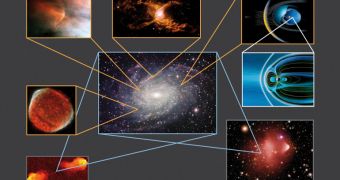A space mission managed by the European Space Agency (ESA) was recently able to shed more light on a complex physical phenomenon, which involves the acceleration of particles in deep-space as if inside a man-made particle accelerators. The initial stages of the process are now understood.
The ESA Cluster mission managed to study the particle acceleration process, and determined that it is far more efficient than physicists initially gave it credit for. During the same investigation, the mechanisms these accelerators use to initiate particle acceleration were also deciphered.
Though the research was carried out close to our planet, investigators say that the exact same principle may apply in all cosmic particle accelerators. Such a structure is an area of open space where magnetic and electric fields are so strong, that every particle captured within is accelerate to high energies.
The same principle applies in facilities constructed by scientists, where magnets placed inside a circular tunnel are used to create strong electromagnetic fields for accelerating protons or elementary particles.
Some time ago, astrophysicists were surprised to find the exact same thing happening in space, although at a much larger scale, usually around dead stars or other such structures. Interestingly, the initial and intermediary steps we use in particle acceleration were also discovered in space.
For example, the Large Hadron Collider – the biggest and most complex particle accelerator ever built – needs several smaller accelerators to get its particles beam up to speed, before they are injected in the main ring, where they are accelerated further.
The same thing may be happening throughout the Universe when it comes to the creation of cosmic rays. Instead of using smaller accelerators, giant electromagnetic fields in space simply increase the temperature of their electrons. This creates the necessary conditions for large-scale acceleration.
One of the most interesting things Cluster uncovered was that the shock wave which generally increased the temperature of electrons was extremely thin. Experts say that a thinner shock wave can accelerate particles more easily than a thick one.
“With these observations, we found that the shock layer is about as thin as it can possibly be,” Imperial College London (ICL) investigator Steven J. Schwartz explains. He says that some of the thinnest shock waves Cluster discovered were only 17 kilometers (10.5 mileas) across.
“This new result reveals the size of the proverbial 'black box', constraining the possible mechanisms within it involved in accelerating particles. Yet again, Cluster has provided us with a clear insight into a physical process that occurs throughout the Universe,” ESA Cluster project scientist Matt Taylor says.

 14 DAY TRIAL //
14 DAY TRIAL //